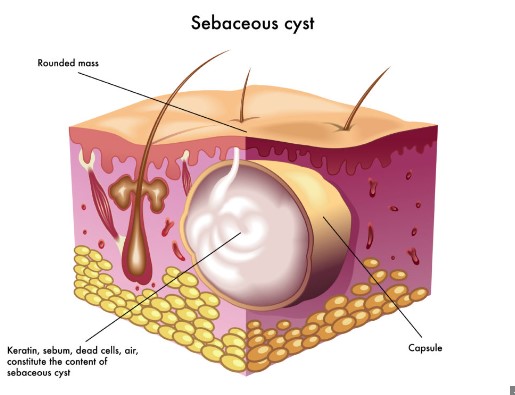BOURSESSENEGAL – Cyst are common growths that can appear in various parts of the body. Learning how to identify cysts, their causes, and treatment options can empower you to manage your health effectively. This comprehensive guide will cover everything you need to know about cysts, from their types to symptoms and treatments. Let’s dive in!
What is a Cyst?
Definition and Characteristics
A cyst is a closed sac filled with fluid, semi-solid material, or gas. They can form in different tissues and can vary in size. Some cysts remain small and harmless, while others can grow larger and cause discomfort or complications.
Common Types of Cysts
Cysts can develop in various locations in the body. Here are a few common types:
- Epidermoid Cysts: These small, round bumps typically appear on the skin. They contain a protein called keratin and are often painless.
- Sebaceous Cysts: Similar to epidermoid cysts, these develop in sebaceous glands. They can become inflamed and may have a yellowish color.
- Ovarian Cysts: Women may experience these cysts in or on their ovaries. They can affect menstrual cycles and may cause pain.
- Baker’s Cysts: Found behind the knee, these cysts can result from joint conditions like arthritis.
Causes of Cysts
1. Blocked Ducts
One common cause of cysts is the blockage of ducts in glands or organs. When these ducts become obstructed, fluid can accumulate, leading to cyst formation.
2. Infection
Infections can also lead to cysts. The body may form a cyst to contain the infection, which helps prevent it from spreading.
3. Genetic Factors
Some individuals may have a genetic predisposition to developing cysts. Conditions like Gardner syndrome or polycystic kidney disease increase the likelihood of cyst formation.
4. Inflammation
Chronic inflammation in certain areas can result in cysts. For example, persistent inflammation in the skin or joints can contribute to cyst development.
Symptoms of Cysts
Recognizing Common Symptoms
While many cysts are asymptomatic, some may cause noticeable symptoms. Here are signs to watch for:
- Visible Swelling: A noticeable lump or bump on the skin.
- Pain or Discomfort: Some cysts can become painful, especially if they are inflamed or infected.
- Skin Changes: The skin over a cyst may appear red or warm to the touch.
- Fluid Drainage: If a cyst ruptures, it may leak fluid, resulting in a foul odor.
When to Seek Medical Attention
If you experience any of the following symptoms, consult a healthcare provider:
- Rapidly growing cysts
- Persistent pain
- Signs of infection, such as fever or increased redness
- Cysts in sensitive areas, such as the breast or abdomen
Diagnosis of Cysts
1. Physical Examination
Healthcare professionals often begin with a physical examination. They will assess the size, shape, and tenderness of the cyst.
2. Imaging Tests
If needed, doctors may order imaging tests like ultrasounds or CT scans. These tests help visualize the cyst’s location and size, aiding in diagnosis and treatment planning.
3. Biopsy
In some cases, a biopsy may be necessary to determine the cyst’s nature. This involves removing a small tissue sample for laboratory analysis.
Treatment Options for Cysts
1. Watchful Waiting
Many cysts do not require treatment. If a cyst is small and asymptomatic, doctors may recommend a wait-and-see approach.
2. Drainage
If a cyst becomes large or painful, a healthcare provider may recommend drainage. This procedure involves making a small incision and allowing the fluid to escape.
3. Medications
Infected cysts may require antibiotic treatment. Your doctor may prescribe medication to address the infection and reduce inflammation.
4. Surgical Removal
If cysts recur or cause significant discomfort, surgical removal may be the best option. This procedure involves excising the cyst and surrounding tissue to prevent regrowth.
Home Remedies for Cysts
1. Warm Compresses
Applying warm compresses to a cyst can help reduce swelling and discomfort. This method encourages drainage if the cyst is near the skin’s surface.
2. Essential Oils
Some essential oils, like tea tree oil, possess antibacterial properties. Diluting the oil and applying it to the cyst may help alleviate symptoms.
3. Over-the-Counter Pain Relief
Pain relievers, such as ibuprofen or acetaminophen, can help manage discomfort associated with cysts. Always follow dosage instructions on the packaging.
4. Avoid Squeezing
While it may be tempting, avoid squeezing or popping cysts. This can lead to infection and complications.
Prevention of Cysts
1. Maintain Good Hygiene
Keeping the skin clean can help prevent the formation of cysts, especially epidermoid and sebaceous types. Regularly washing your skin can minimize the risk of clogged pores.
2. Healthy Lifestyle Choices
Eating a balanced diet, staying hydrated, and exercising regularly can improve overall skin health. These lifestyle choices may help prevent cysts related to inflammation or hormonal changes.
3. Regular Check-ups
Schedule regular medical check-ups to monitor any existing cysts and discuss potential risk factors with your healthcare provider.
Conclusion: Understanding Cysts for Better Health
Understanding cysts can empower you to manage your health effectively. While many cysts are harmless and don’t require treatment, it’s essential to recognize the symptoms and seek medical advice when necessary.
By learning how to identify cysts, knowing their causes, and being aware of treatment options, you can take control of your health. If you notice changes or symptoms related to cysts, don’t hesitate to consult a healthcare professional. Your health matters, and staying informed is key!
REFERENCE : nagaslot99



